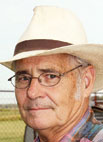
The eastern Oklahoma farm of Arlus Walters gives the feeling you’ve stepped back in time to a simpler place. No strip malls, no gas stations, just the small community church right up the road. That is how Arlus Walters prefers things.
Mr. Walters is a man who prefers things of historical value, that have a style all of their own. His eyes light up upon showing his vintage '59 Ford Skyliner and immaculate ’57 Ford Fairlane.
This love for the unique and vintage also flows over to his farming operation. Arlus has been working with heritage breed turkeys for years now. Working in conjunction with his son Mike, Walters Hatchery became internationally known for their delicious, free range, heritage turkeys after being featured in the likes of magazines such as Martha Stewart Living.
After producing hundreds of head a year, trucking them to Ohio for processing, and selling to the gourmet food distributor Dean and Deluca, Arlus has scaled back his operation.
Arlus is now focused on working toward his goal of reclaiming heritage breeds of turkeys that were thought to be lost to the ages through the cross breeding of lines. Heritage breed turkeys were originally bred for flavor, beauty and their hardy immune systems. Turkeys of the past had to be tough, as they were sometimes herded to market in flocks. By the 1960’s the heritage breeds had been driven from the market by the Broad Breasted White. By 1990 they were near extinction.
The American Livestock Breed Conservancy, and small farmers like Arlus have taken the time and care to preserve and nurture these breeds. The chocolate turkey is one of the two breeds that Arlus is re-developing.
The chocolate turkey was common in the Southern United States and France before the onset of the Civil War. Large numbers of chocolate turkey breeders were lost during the war years and the breed never regained its pre-war popularity. Chocolate describes the color of this breeds feathers, shanks and feet. Arlus works tirelessly with each new batch of chocolates, removing those that still contain the remnants of past crosses, such as Narangansett feathers. Those birds will be sold through the Oklahoma Food Cooperative as special Thanksgiving treats for those lucky enough to purchase one before they’re quickly sold out.
The second breed that Arlus is working toward restoring is the Buff turkey. The Buff was accepted into the Standard of Perfection (the official breed standard of the poultry fancy) in 1874. The Buff was one of several breeds used to develop the Bourbon Red. The Buff breed died out entirely by the early 1900’s. In the 1940’s interest in the Buff was renewed and a new strain called the New Jersey Buff was developed.
Arlus is working methodically to breed out the remnants of the Bourbon Red in his Buff stock and revive the original standard of the bird. Those standards are that the bird should have very light or reddish brown plumage. Currently some of his birds are still displaying white on their wing feathers, which he is working to breed out, to obtain the consistent all over reddish brown plumage.
Another issue that faces a heritage breed farmer as opposed to a commercial turkey producer is reproduction. In addition for selecting for breed conformity, Arlus must select for long legs in his toms, to facilitate natural mating.
Raising free range, heritage turkeys has its frustrations, along with the selection process you have to contend with predators. This point was brought home when, while holding a turkey in one hand, Arlus picked up a six foot long black snake that had worked its way into the pen for a quick helping of turkey.
Vigor and great immune systems are what Arlus views as one of the pluses of working with heritage breeds. Despite the hard work and frustration that comes with selectively breeding, you get the feeling that Arlus Walters wouldn’t have it any other way.
When asked why he does this demanding work, Arlus concluded, “Because it’s a challenge. If you’re a farmer and you have a Hereford cow, you want it to look like a Hereford. It’s just a better breed that way.”







